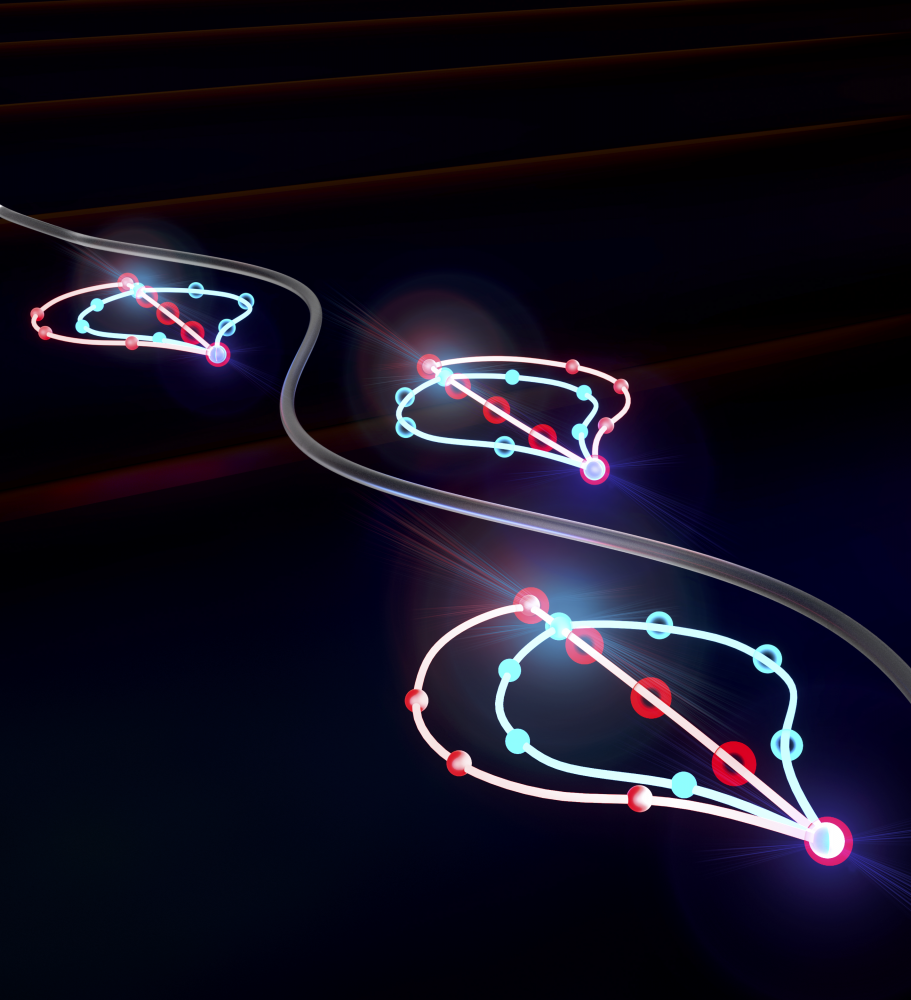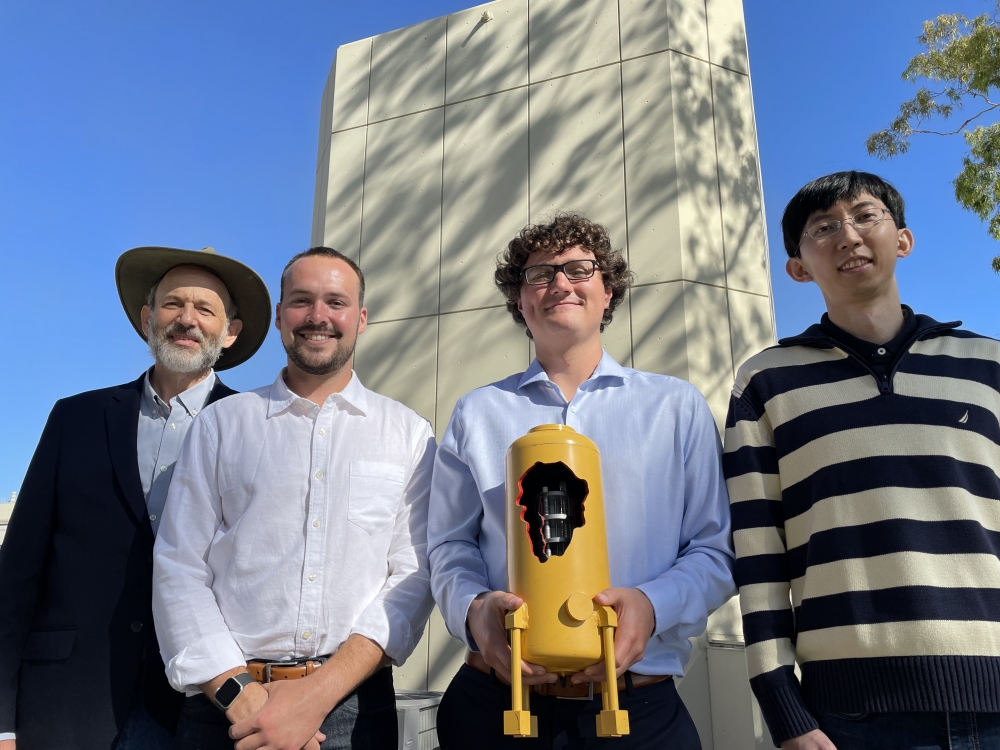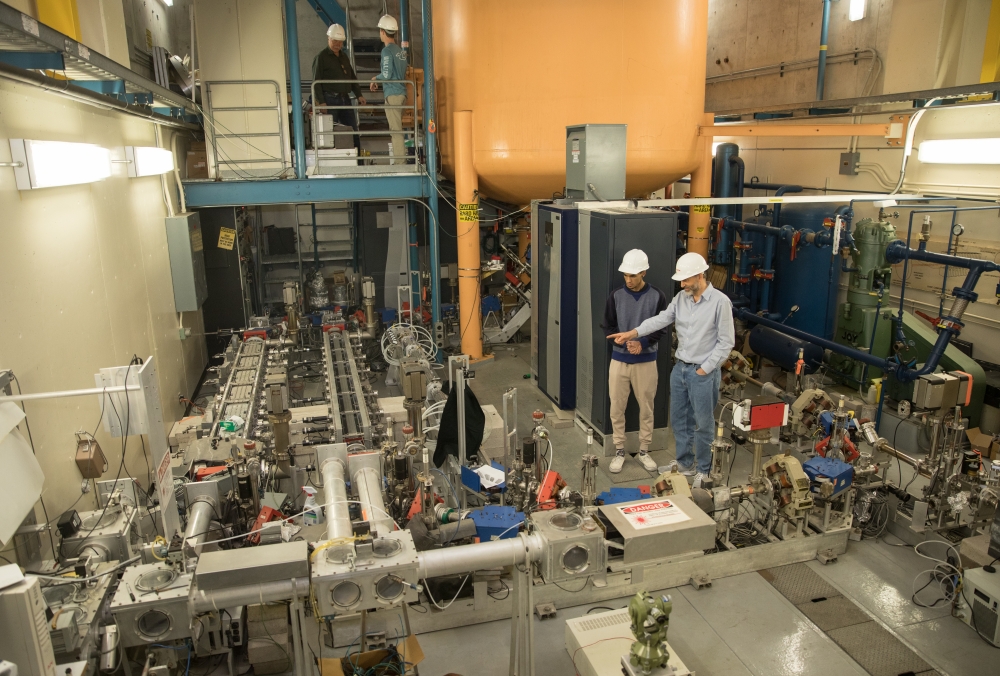
Working Through a Mental Bloch

Lightspeed is the fastest velocity in the universe. Except when it isn’t. Anyone who’s seen a prism split white light into a rainbow has witnessed how material properties can influence the behavior of quantum objects: in this case, the speed at which light propagates.
Electrons also behave differently in materials than they do in free space, and understanding how is critical for scientists studying material properties and engineers looking to develop new technologies. “An electron’s wave nature is very particular. And if you want to design devices in the future that take advantage of this quantum mechanical nature, you need to know those wavefunctions really well,” explained co-author Joe Costello, a UC Santa Barbara graduate student in condensed matter physics.
In a new paper, co-lead authors Costello, Seamus O’Hara and Qile Wu and their collaborators developed a method to calculate this wave nature, called a Bloch wavefunction, from physical measurements. “This is the first time that there’s been experimental reconstruction of a Bloch wavefunction,” said senior author Mark Sherwin, a professor of condensed matter physics at UC Santa Barbara. The team’s findings appear in the journal Nature, coming out more than 90 years after Felix Bloch first described the behavior of electrons in crystalline solids.
Like all matter, electrons can behave as particles and waves. Their wave-like properties are described by mathematical objects called wavefunctions. These functions have both real and imaginary components, making them what mathematicians call “complex” functions. As such, the value of an electron’s Bloch wavefunction isn’t directly measurable; however, properties related to it can be directly observed.
Understanding Bloch wavefunctions is crucial to designing the devices engineers have envisioned for the future, Sherwin said. The challenge has been that, because of inevitable randomness in a material, the electrons get bumped around and their wavefunctions scatter, as O’Hara explained. This happens extremely quickly, on the order of a hundred femtoseconds (less than one millionth of one millionth of a second). This has prevented researchers from getting an accurate enough measurement of the electron’s wavelike properties in a material itself to reconstruct the Bloch wavefunction.
Fortunately, the Sherwin group was the right set of people, with the right set of equipment, to tackle this challenge.

Mark Sherwin (bottom right) explains the inner workings of the free-electron laser. The large yellow tank accelerates electrons, which are guided along the beam line and into the “wigglers” at the far left.
Photo Credit: UC SANTA BARBARA
The researchers used a simple material, gallium arsenide, to conduct their experiment. All of the electrons in the material are initially stuck in bonds between Ga and As atoms. Using a low intensity, high frequency infrared laser, they excited electrons in the material. This extra energy frees some electrons from these bonds, making them more mobile. Each freed electron leaves behind a positively charged “hole,” a bit like a bubble in water. In gallium arsenide, there are two kinds of holes, “heavy” holes and “light” holes, which behave like particles with different masses, Sherwin explained. This slight difference was critical later on.
All this time, a powerful terahertz laser was creating an oscillating electric field within the material that could accelerate these newly unfettered charges. If the mobile electrons and holes were created at the right time, they would accelerate away from each other, slow, stop, then speed toward each other and recombine. At this point, they would emit a pulse of light, called a sideband, with a characteristic energy. This sideband emission encoded information about the quantum wavefunctions including their phases, or how offset the waves were from each other.
Because the light and heavy holes accelerated at different rates in the terahertz laser field, their Bloch wavefunctions acquired different quantum phases before they recombined with the electrons. As a result, their wavefunctions interfered with each other to produce the final emission measured by the apparatus. This interference also dictated the polarization of the final sideband, which could be circular or elliptical even though the polarization of both lasers was linear.
It’s the polarization that connects the experimental data to the quantum theory, which was expounded upon by postdoctoral researcher Qile Wu. Qile’s theory has only one free parameter, a real-valued number that connects the theory to the experimental data. “So we have a very simple relation that connects the fundamental quantum mechanical theory to the real-world experiment,” Wu said.
“Qile's parameter fully describes the Bloch wavefunctions of the hole we create in the gallium arsenide,” explained co-first author Seamus O’Hara, a doctoral student in the Sherwin group. The team can acquire this by measuring the sideband polarization and then reconstruct the wavefunctions, which vary based on the angle at which the hole is propagating in the crystal. “Qile's elegant theory connects the parameterized Bloch wavefunctions to the type of light we should be observing experimentally.”
“The reason the Bloch wavefunctions are important,” Sherwin added, “is because, for almost any calculation you want to do involving the holes, you need to know the Bloch wavefunction.”
Currently scientists and engineers have to rely on theories with many poorly-known parameters. “So, if we can accurately reconstruct Bloch wavefunctions in a variety of materials, then that will inform the design and engineering of all kinds of useful and interesting things like laser, detectors, and even some quantum computing architectures,” Sherwin said.
This achievement is the result of over a decade of work, combined with a motivated team and the right equipment. A meeting between Sherwin and Renbao Liu, at the Chinese University of Hong Kong, at a conference in 2009 precipitated this research project. “It’s not like we set out 10 years ago to measure Bloch wavefunctions,” he said; “the possibility emerged over the course of the last decade.”
Sherwin realized that the unique, building-sized UC Santa Barbara Free-Electron Lasers could provide the strong terahertz electric fields necessary to accelerate and collide electrons and holes, while at the same time possessing a very precisely tunable frequency.
The team didn’t initially understand their data, and it took a while to recognize that the sideband polarization was the key to reconstructing the wavefunctions. “We scratched our heads over that for a couple of years,” said Sherwin, “and, with Qile’s help, we eventually figured out that the polarization was really telling us a lot.”
Now that they’ve validated the measurement of Bloch wavefunctions in a material they are familiar with, the team is eager to apply their technique to novel materials and more exotic quasiparticles. “Our hope is that we get some interest from groups with exciting new materials who want to learn more about the Bloch wavefunction,” Costello said.



